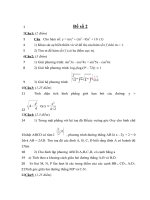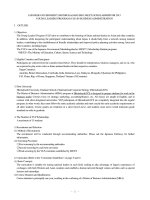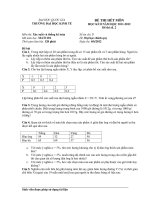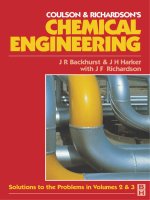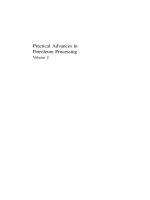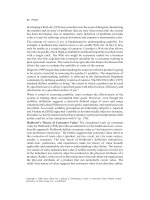2013 single best answer MCQs in anaesthesia 2c volume 2 basic sciences n
Bạn đang xem bản rút gọn của tài liệu. Xem và tải ngay bản đầy đủ của tài liệu tại đây (12.76 MB, 212 trang )
SBA cover II.qxd 01/07/2011 12:46 Page 1
contains 30 single best answer questions on physiology, pharmacology,
clinical measurement and physics. The scenarios are based on the application
of a wide knowledge of basic sciences relevant to the clinical practice of
anaesthesia. The best possible answer to a given question is substantiated by
detailed explanation drawn from recent journal articles and textbooks of
anaesthesia and basic sciences. These questions enable the candidates to
assess their knowledge in basic sciences and their ability to apply it to clinical
Single Best Answer MCQs in Anaesthesia
This book comprises six sets of single best answer practice papers. Each set
practice.
Single Best Answer MCQs in
ANAESTHESIA
Alongside the previously published book Single Best Answer MCQs in
Anaesthesia (Volume I – Clinical Anaesthesia, ISBN 978-1-903378-75-5), this
book is an ideal companion for candidates sitting postgraduate examinations
in anaesthesia, intensive care medicine, and pain management. It will also be
a valuable educational resource for all trainees and practising anaesthetists.
Volume II Basic Sciences
tf m
Cyprian Mendonca, Mahesh Chaudhari, Arumugam Pitchiah
Prelims MCQ book_Prelims MCQ book.qxd 11-05-2013 18:19 Page i
Single Best Answer MCQs in
ANAESTHESIA
Volume II Basic Sciences
Cyprian Mendonca, Mahesh Chaudhari, Arumugam Pitchiah
Prelims MCQ book_Prelims MCQ book.qxd 11-05-2013 18:19 Page ii
Single Best Answer MCQs in Anaesthesia
tfm Publishing Limited, Castle Hill Barns, Harley, Nr Shrewsbury, SY5
6LX, UK. Tel: +44 (0)1952 510061; Fax: +44 (0)1952 510192
E-mail: ; Web site: www.tfmpublishing.com
ii
Design & Typesetting:
First Edition:
Background cover image
Paperback
Nikki Bramhill BSc Hons Dip Law
© September 2011
© Comstock Inc., www.comstock.com
ISBN: 978-1-903378-83-0
E-book editions:
ePub
Mobi
Web pdf
2013
ISBN: 978-1-908986-84-9
ISBN: 978-1-908986-85-6
ISBN: 978-1-908986-86-3
The entire contents of ‘Single Best Answer MCQs in Anaesthesia’ is
copyright tfm Publishing Ltd. Apart from any fair dealing for the purposes
of research or private study, or criticism or review, as permitted under the
Copyright, Designs and Patents Act 1988, this publication may not be
reproduced, stored in a retrieval system or transmitted in any form or by
any means, electronic, digital, mechanical, photocopying, recording or
otherwise, without the prior written permission of the publisher.
Neither the authors nor the publisher can accept responsibility for any
injury or damage to persons or property occasioned through the
implementation of any ideas or use of any product described herein.
Neither can they accept any responsibility for errors, omissions or
misrepresentations, howsoever caused.
Whilst every care is taken by the authors and the publisher to ensure that
all information and data in this book are as accurate as possible at the time
of going to press, it is recommended that readers seek independent
verification of advice on drug or other product usage, surgical techniques
and clinical processes prior to their use.
The authors and publisher gratefully acknowledge the permission granted
to reproduce the copyright material where applicable in this book. Every
effort has been made to trace copyright holders and to obtain their
permission for the use of copyright material. The publisher apologizes for
any errors or omissions and would be grateful if notified of any corrections
that should be incorporated in future reprints or editions of this book.
Printed by Gutenberg Press Ltd., Gudja Road, Tarxien, PLA 19, Malta.
Tel: +356 21897037; Fax: +356 21800069.
Prelims MCQ book_Prelims MCQ book.qxd 11-05-2013 18:19 Page iii
Contents
Page
Preface
Acknowledgements
Abbreviations
Set 1
Set 1
Set 2
Set 2
Set 3
Set 3
Set 4
Set 4
Set 5
Set 5
Set 6
Set 6
Questions
iv
vi
viii
1
Answers
13
Questions
33
Answers
Questions
Answers
Questions
Answers
Questions
Answers
Questions
Answers
45
69
81
103
113
135
147
169
181
iii
Prelims MCQ book_Prelims MCQ book.qxd 11-05-2013 18:19 Page iv
Preface
Single best answer type multiple choice questions have been
iv
introduced into anaesthetic postgraduate examinations as a way of
assessing the trainee’s ability to apply knowledge to clinical practice.
Although this is more relevant for topics in clinical anesthesia, recently this
method of assessment has been extended to topics in basic sciences.
This book consists of six sets of single best answer practice papers.
Each set comprises 30 multiple choice questions drawn from physiology,
pharmacology, clinical measurement, equipment and physics relevant to
anaesthetic examinations. Each question consists of a stem describing a
clinical scenario or problem followed by five possible answer options. One
of them is the best response for the given question. Each question and
answer is accompanied by supporting notes obtained from peer-reviewed
journal articles and basic science textbooks. Alongside the previously
published book Single Best Answer MCQs in Anaesthesia (Volume I –
Clinical Anaesthesia, ISBN 978-1-903378-75-5), this book supplements
the essential study material for postgraduate anaesthetic examinations.
The main objective of this book is to provide trainees with a series of
single best answer type questions that will prepare them for this format of
postgraduate examinations. Much emphasis has been placed on the
understanding and application of basic science knowledge with regards to
clinical practice.
Prelims MCQ book_Prelims MCQ book.qxd 11-05-2013 18:19 Page v
We hope that a thorough revision of this book will enable trainees to
improve their understanding and core knowledge of basic sciences
relevant to anaesthesia. We believe this book will not only be an invaluable
educational resource for those who are preparing for postgraduate
examinations, but will also be of benefit to any practising anaesthetist.
Cyprian Mendonca MD, FRCA
Consultant Anaesthetist
University Hospitals Coventry and Warwickshire
Coventry, UK
Mahesh Chaudhari MD, FRCA, FFPMRCA
Consultant Anaesthetist
Worcestershire Royal Hospital
Worcester, UK
Arumugam Pitchiah MD, FRCA
Specialty Registrar
Welsh School of Anaesthesia
Wales, UK
v
Prelims MCQ book_Prelims MCQ book.qxd 11-05-2013 18:19 Page vi
Acknowledgements
vi
We are grateful to Dr Jennie Kerr and Dr Clare Ingram, both Specialty
Registrars, Warwickshire School of Anaesthesia, who critically reviewed
the entire manuscript and made suggestions for improvement of the book.
We gratefully acknowledge the help received from Nikki Bramhill, Director,
tfm publishing, in reviewing the manuscript.
We extend our thanks to the following who contributed questions to this
book:
Dr S Pradeep Angadi
Specialty Registrar, East Midlands (South) School of Anaesthesia
Dr Shefali Chaudhari
Specialty Registrar, Warwickshire School of Anaesthesia
Dr Smita Gohil
Specialty Registrar, Warwickshire School of Anaesthesia
Dr Kate Henderson
Specialty Registrar, Birmingham School of Anaesthesia
Dr Carl Hillermann
Consultant Anaesthetist, University Hospital, Coventry
Prelims MCQ book_Prelims MCQ book.qxd 11-05-2013 18:19 Page vii
Dr Payal Kajekar
Specialty Registrar, Warwickshire School of Anaesthesia
Dr Raja Lakshmanan
Consultant Anaesthetist, Queen Elizabeth Hospital, Birmingham
Dr Deepak Malik
Specialty Registrar, East Midlands (South) School of Anaesthesia
Dr Priya Nair
Specialty Registrar, Warwickshire School of Anaesthesia
Dr Shanmugam Paramasivan
Specialty Registrar, Warwickshire School of Anaesthesia
Dr Ganesh K Ramalingam
Specialty Registrar, Warwickshire School of Anaesthesia
Dr Rathinavel Shanmugam
Specialty Registrar, Warwickshire School of Anaesthesia
Dr Rebecca Smith
Specialty Registrar, St. George’s School of Anaesthesia
vii
Prelims MCQ book_Prelims MCQ book.qxd 11-05-2013 18:19 Page viii
Abbreviations
viii
AAGBI
ACE
ACTH
ADH
ALA
AOP
APTT
ARDS
ASA
AST
BD
BP
cAMP
CBF
CI
CK
Cl
CMR
CNS
CO
CO
COAD
COPD
CPAP
CPP
CPR
CSF
CSWS
CT
CVP
Association of Anaesthetists of Great Britain and Ireland
Angiotensin-converting enzyme
Adrenocorticotrophic hormone
Anti-diuretic hormone
d-aminolevulinic acid
Apnoea of prematurity
Activated partial thromboplastin time
Acute respiratory distress syndrome
American Society of Anesthesiologists
Aspartate transaminase
Twice a day
Blood pressure
Cyclic adenosine monophosphate
Cerebral blood flow
Cardiac index
Creatine kinase
Chloride
Cerebral metabolic rate
Central nervous system
Carbon monoxide
Cardiac output
Chronic obstructive airway disease
Chronic obstructive pulmonary disease
Continuous positive airway pressure
Cerebral perfusion pressure
Cardiopulmonary resuscitation
Cerebrospinal fluid
Cerebral salt wasting syndrome
Computed tomography
Central venous pressure
Prelims MCQ book_Prelims MCQ book.qxd 11-05-2013 18:19 Page ix
Abbreviations
DPG
EBV
ECF
ECG
EDV
EEG
EF
ESR
ESV
EtCO2
FEUA
FEV
FFA
FGF
FRC
FVC
GA
GTN
H
Hb
HBO
HCO3
HME
HPV
IABP
IBW
ICF
ICP
ICU
IV
K
LA
LDH
LMA
LMWH
MABL
MAC
MAOI
MAP
MRA
2,3-diphosphoglycerate
Estimated blood volume
Extracellular fluid
Electrocardiogram
End-diastolic volume
Electro-encephalography
Ejection fraction
Erythrocyte sedimentation rate
End-systolic volume
End-tidal CO2
Fractional excretion of uric acid
Forced expiratory volume
Free fatty acids
Fresh gas flow
Functional residual capacity
Forced vital capacity
General anaesthesia
Glyceryl trinitrate
Hydrogen
Haemoglobin
Hyperbaric oxygen
Bicarbonate
Heat-moisture exchange
Hypoxic pulmonary vasoconstriction
Intra-aortic balloon pump
Ideal body weight
Intracellular fluid
Intracranial pressure
Intensive care unit
Intravenous
Potassium
Local anaesthesia
Lactic dehydrogenase
Laryngeal mask airway
Low-molecular-weight heparin
Maximum allowable blood loss
Minimum alveolar concentration
Monoamine oxidase inhibitor
Mean arterial pressure
Magnetic resonance angiography
ix
Prelims MCQ book_Prelims MCQ book.qxd 11-05-2013 18:19 Page x
Single Best Answer MCQs in Anaesthesia
x
MRI
MST
Na
NMB
NSAID
OD
PAP
PAWP
PCT
PCV
PDE
PDPH
PEEP
PMR
PONV
PT
PTH
PVR
PVRI
RBC
RV
SIADH
SLN
STP
SVP
SVR
SVRI
TBW
TCA
TCI
TDS
TEF
TOE
TOF
TPN
TRH
TSH
VAE
VIE
VSD
Magnetic resonance imaging
Morphine sulphate
Sodium
Neuromuscular block
Non-steroidal anti-inflammatory drug
Once a day
Pulmonary artery pressure
Pulmonary artery wedge pressure
Proximal convoluted tubule
Packed cell volume
Phosphodiesterase
Postdural puncture headache
Positive end expiratory pressure
Polymyalgia rheumatica
Postoperative nausea and vomiting
Prothrombin time
Parathyroid hormone
Pulmonary vascular resistance
Pulmonary vascular resistance index
Red blood cell
Residual volume
Syndrome of inappropriate anti-diuretic hormone secretion
Superior laryngeal nerve
Standard temperature and pressure
Saturated vapour pressure
Systemic vascular resistance
Systemic vascular resistance index
Total body water
Tricyclic antidepressant
Target controlled infusion
Three times a day
Tracheo-oesophageal fistulae
Transoesophageal echocardiogram
Train of four
Total parenteral nutrition
Thyrotropin releasing hormone
Thyroid stimulating hormone
Venous air embolism
Vacuum-insulated evaporator
Ventricular septal defect
set 1_set 1.qxd 11-05-2013 19:00 Page 1
Set 1
a.
b.
c.
d.
e.
2
a.
b.
c.
d.
e.
3
Set 1
1
questions
Which of the following is the most effective process to maintain an
energy supply to muscles during physical exertion in trained athletes
(as compared to untrained individuals)?
Protein catabolism.
Effective utilisation of free fatty acids.
More glycogen utilisation.
More lactate production.
Gluconeogenesis by deamination.
A 47-year-old female is due to undergo a hysterectomy. Her preoperative ECG shows progressive lengthening of the PR interval
until a ventricular beat is dropped. Which of the following
conduction abnormalities is she most likely to have?
First degree heart block.
Mobitz type 1 heart block.
Mobitz type 2 heart block.
Left bundle branch block.
Right bundle branch block.
Hypoxic pulmonary vasoconstriction (HPV) in the lungs is a
compensatory
mechanism to improve ventilation perfusion
1
set 1_set 1.qxd 11-05-2013 19:00 Page 2
Single Best Answer MCQs in Anaesthesia
matching. In which of the following would a decrease most likely
trigger HPV?
a.
b.
c.
d.
e.
2
4
a.
b.
c.
d.
e.
5
a.
b.
c.
d.
e.
Partial pressure of oxygen in the pulmonary artery.
Partial pressure of oxygen in the pulmonary veins.
Partial pressure of oxygen in the alveoli.
Oxygen saturation of haemoglobin in the pulmonary artery.
Oxygen saturation of haemoglobin in the pulmonary veins.
You perform an uncomplicated lumbar epidural for labour analgesia
on a 27-year-old lady of 36 weeks’ gestation with twins. Immediately
after the test dose of 15ml 0.25% bupivacaine she lies supine and
her BP is 70/40. The most likely cause for hypotension in this patient
is:
Concealed ante-partum haemorrhage.
Intrathecal injection of local anaesthetic.
Dehydration.
Aorto-caval compression.
Anaphylaxis.
A 35-year-old patient with a BMI of 35 aspirates gastric contents on
induction of anaesthesia. One week later on the ICU, a diagnosis of
acute respiratory distress syndrome is made. Which of the following
mechanisms is most likely to contribute to the associated pulmonary
oedema?
Increased pulmonary capillary permeability.
Raised pulmonary capillary hydrostatic pressure due to fluid
overload.
Reduced lymphatic drainage.
Reduced alveolar interstitial pressure.
Decreased oncotic pressure in the pulmonary capillary.
set 1_set 1.qxd 11-05-2013 19:00 Page 3
6
a.
b.
c.
d.
e.
7
a.
b.
c.
d.
e.
8
a.
b.
c.
d.
e.
Set 1 questions
A 29-year-old woman on lithium for bipolar disease was brought to
the emergency department where she was found to be
unresponsive. She has a history of convulsions and her ECG shows
conduction defects with ST changes. Plasma lithium levels were
found to be 7.5mmol/L. In addition to supportive treatment, specific
management would be:
Haemodialysis.
Administration of magnesium.
Forced alkaline diuresis.
Acetazolamide administration.
Diazepam infusion.
A 66-year-old male with hypertension and ischemic heart disease is
scheduled for an open cholecystectomy. The best technique among
the following to suppress the pressor response to laryngoscopy and
intubation would be:
Intravenous esmolol.
Morphine 0.4mg/kg prior to intubation.
Isoflurane.
Intravenous phentolamine.
GTN spray prior to induction.
A 53-year-old woman suffering from chronic back pain presents for
excision of a small lipoma on the forearm under general anaesthesia.
Her regular medication includes 100mg of morphine sulphate
continuous twice daily. In the postoperative period the optimal dose
of oral morphine to be prescribed would be:
20mg every 4 hours with extra doses of 20mg for breakthrough pain.
30mg every 4 hours with extra doses of 30mg for breakthrough pain.
20mg every 6 hours with extra doses of 20mg for breakthrough pain.
30mg every 8 hours with extra doses of 30mg for breakthrough pain.
30mg every 2 hours with extra doses of 30mg for breakthrough pain.
3
set 1_set 1.qxd 11-05-2013 19:00 Page 4
Single Best Answer MCQs in Anaesthesia
9
4
a.
b.
c.
d.
e.
A 9-year-old boy weighing 40kg is undergoing an appendicectomy.
He became severely hypotensive 5 minutes after the administration
of an antibiotic. He developed a rash all over his body. His blood
pressure is 65/45mmHg, his heart rate is 140 per minute and he has
weak central pulses. The most appropriate dose and route of
administering adrenaline is:
0.1ml/kg
0.1ml/kg
0.1ml/kg
0.1ml/kg
0.1ml/kg
of
of
of
of
of
1:10 000 adrenaline IV.
1:100 000 adrenaline IV.
1:1000 adrenaline IV.
1:10 000 adrenaline IM.
1: 20 000 adrenaline IM.
10 A 47-year-old woman is scheduled for an elective total abdominal
hysterectomy. She consents for a lumbar epidural for postoperative
analgesia. In the anaesthetic room, at 10am, it is noted from her
prescription chart that she has had a prophylactic dose of
enoxaparin the previous evening at 22:00 hours. The best
management option is:
a.
b.
c.
d.
e.
To avoid the epidural and choose an alternative method of
postoperative analgesia.
To continue with the scheduled plan of epidural analgesia.
To postpone surgery to another day.
To estimate anti-Xa levels prior to insertion.
To review PT and APTT prior to insertion.
11 A patient is receiving oxygen at a rate of 10L/minute, from a size E
cylinder (volume 5L). The pressure in the cylinder is 100 bar. How
long can oxygen be delivered from this cylinder?
a.
b.
c.
d.
e.
30
40
45
50
60
minutes.
minutes.
minutes.
minutes.
minutes.
set 1_set 1.qxd 11-05-2013 19:00 Page 5
12 You
Set 1 questions
are starting the first case on a Sunday morning in the
emergency theatre. After induction of general anaesthesia, despite
adequate mask ventilation using 6L/minute of oxygen flow, the
oxygen saturation begins to fall. The oxygen analyser at the common
gas outlet (fuel cell) and at the mask end of the breathing system
(paramagnetic analyser) reads inspired oxygen concentration as
21%. Despite turning the oxygen cylinder on (pressure reads 90
bar), the oxygen saturation continues to fall. The single most
important next step in the management is:
a.
b.
c.
d.
e.
Immediate tracheal intubation.
Ventilate using a resuscitation bag and auxiliary oxygen source from
the same anaesthetic machine.
Change the pulse oximeter probe.
Disconnect the oxygen pipeline.
Change the oxygen cylinder on the machine.
13 A 60-year-old male patient is ventilated using volume-controlled
ventilation. The normal waveform of EtCO2 gradually (over 15
minutes) changes to the following trace (Figure 1). Which of the
following situations best describes the change in the EtCO2
waveform?
Figure 1.
Volume-controlled ventilation EtCO2 waveform.
5
set 1_set 1.qxd 11-05-2013 19:00 Page 6
Single Best Answer MCQs in Anaesthesia
a.
b.
c.
d.
e.
Spontaneous breathing.
Hypoventilation.
Malfunction of inspiratory valve.
Malfunction of expiratory valve.
Exhaustion of CO2 absorber.
14 The figure below is an arterial trace from a 70-year-old patient with
chronic obstructive airway disease, in the intensive care unit. This
trace indicates:
6
Figure 2.
a.
b.
c.
d.
e.
Arterial trace.
Presence of blood clot in the cannula.
An under-damped trace.
Compliant tubing.
Atrial fibrillation.
Kinking of the cannula.
set 1_set 1.qxd 11-05-2013 19:00 Page 7
15 You
Set 1 questions
are planning to perform a gas induction with sevoflurane
(molecular weight = 200 and density = 1.5). The vaporiser dial is set
at 6%, with a fresh gas flow of 5L/minute using a Mapleson A
breathing system. How much liquid sevoflurane is required for the
first 5 minutes?
a.
b.
c.
d.
e.
3ml.
5ml.
7ml.
9ml.
11ml.
16 A 27-year-old man is keen to climb up to the summit of Mount
Everest without using additional oxygen. Which of the following is
the most significant physiological adaptation for his successful
acclimatization?
a.
b.
c.
d.
e.
Increase in 2,3-DPG in red blood cells.
Improved ventilation perfusion matching.
Hyperventilation.
Polycythaemia.
Improved ability of the body to generate energy from anaerobic
metabolism.
17 A female patient with a BMI of 49 is scheduled to undergo gastric
banding surgery. A change in which of the following parameters
confers the greatest advantage when pre-oxygenating her in the
sitting (rather than supine) position?
a.
b.
c.
d.
e.
Vital capacity.
Ventilation/perfusion matching.
Tidal volume.
Closing capacity.
Functional residual capacity.
7
set 1_set 1.qxd 11-05-2013 19:00 Page 8
Single Best Answer MCQs in Anaesthesia
18 A 39-year-old lady was admitted to intensive care from a medical
ward where she was treated for pneumonia and diabetes mellitus.
She is intubated and ventilated. Two hours following intensive
treatment the following parameters were observed (Table 1).
Table 1. Vital parameters.
8
HR
BP
CVP
Body surface area
Cardiac output
Stroke volume
PA pressure
PAWP
SvO2
CaO2
126/minute
80/44 (55)mmHg,
+5mmHg
2m2
8L/min
80ml
25/7(13)mmHg
6mmHg
65%
15ml.dl-1
Her systemic vascular resistance would be:
a.
b.
c.
d.
e.
400dynes.s.cm-5.
500dynes.s.cm-5.
550dynes.s.cm-5.
600dynes.s.cm-5.
650dynes.s.cm-5.
19 A 70-year-old male patient with severe chronic obstructive airway
disease has been intubated and ventilated in the intensive care unit.
Before intubation and ventilation his oxygen saturation was 90%; it
is now 100%. His PaO2 has increased from 8kPa to 20kPa. His
haemoglobin is 15g/dL and pH is 7.32. His oxygen content in the
blood is:
set 1_set 1.qxd 11-05-2013 19:00 Page 9
Set 1 questions
a.
b.
c.
d.
e.
Increased
Increased
Increased
Increased
Increased
by
by
by
by
by
15ml/100ml.
12ml/100ml.
9ml/100ml.
6ml/100ml.
3ml/100ml.
20 A 70-year-old man is scheduled for a knee arthroplasty. Prior to
induction of general anaesthesia a femoral nerve block is
performed using a nerve stimulator. Soon after injection of 20ml of
0.5% bupivacaine, he became unresponsive. He is unconscious
and has no palpable carotid pulse. CPR is commenced. Which
one of the following best describes the specific treatment in this
scenario?
a.
b.
c.
d.
e.
1ml/kg of 10% lipid emulsion over 1 minute.
1.5ml/kg of 20% lipid emulsion over 1 minute.
1.5ml/kg of 20% lipid emulsion over 5 minutes.
1ml/kg of 10% lipid emulsion over 1 minute.
1.5ml/kg of 10% lipid emulsion over 2 minutes.
21 In a 40-year-old male (total body water of this patient is 60L) after
oral administration and absorption, drug A is distributed only in
extracellular fluid. If the terminal half-life of the drug is 500 minutes,
which one of the following most closely represents the clearance
value (ml/minute) for this drug?
a.
b.
c.
d.
e.
14.
28.
20.
34.
40.
9
set 1_set 1.qxd 11-05-2013 19:00 Page 10
Single Best Answer MCQs in Anaesthesia
22 A 38-year-old woman with a body mass index of 48 is to undergo an
elective laparotomy for gynaecological surgery. The induction dose
of propofol is best calculated based on:
a.
b.
c.
d.
e.
10
Actual body weight.
Ideal body weight.
Lean body mass.
Body mass index.
Ideal body weight + 20% total body weight.
23 A 11-year-old obese girl has undergone a tonsillectomy. Later that
evening she is found pale and hypotensive. She is diagnosed with
post-tonsillectomy bleeding. She is very anxious. The preferred
method of induction would be:
a.
b.
c.
d.
e.
Inhalational induction with sevoflurane with a head-down tilt.
Rapid sequence induction with thiopentone and suxamethonium.
Rapid sequence induction with thiopentone and rocuronium.
Rapid sequence induction with propofol and rocuronium.
Inhalational induction with desflurane with a head-down tilt.
24 A 35-year-old woman is brought to the emergency department
following a suspected amitriptyline overdose. She has a GCS of 6
and her blood pressure is 90/46mmHg. A 12-lead ECG is recorded;
it is highly likely to show:
a.
b.
c.
d.
e.
Atrial fibrillation.
Sinus bradycardia with a prolonged QRS complex.
Sinus tachycardia with a prolonged QRS complex.
Complete heart block.
Ventricular tachycardia.
25 A 40-year-old ASA 1 male patient with a body mass index of 28 is
undergoing a complex orthopaedic procedure on the left forearm
lasting for 8 hours. The most appropriate reason for choosing
set 1_set 1.qxd 11-05-2013 19:00 Page 11
Set 1 questions
invasive arterial blood pressure monitoring over automated noninvasive blood pressure measurement in this patient is:
a.
b.
c.
d.
e.
Automated non-invasive blood pressure monitoring would be
inaccurate in this patient.
Automated blood pressure monitoring is likely to result in ulnar nerve
injury.
Monitoring invasive blood pressure ensures adequate perfusion
pressure.
Hypotension can be detected early using invasive blood pressure
monitoring.
Automated non-invasive blood pressure monitoring for 8 hours can
result in distal oedema of the limb.
26 You encountered a difficult laryngoscopy in a patient scheduled for
an emergency laparotomy. The laryngoscopic view was grade 3.
You managed to intubate the trachea by railroading the tracheal tube
over a gum elastic bougie. Which of the following is the most reliable
method of confirming the correct placement of the tracheal tube?
a.
b.
c.
d.
e.
Feeling clicks whilst advancing the bougie.
Distal hold up of bougie.
Presence of CO2 in the initial few breaths.
Presence of bilateral chest movement.
Endoscopic confirmation using a fibreoptic scope.
27 A 65-year-old male patient presents with severe shortness of breath
due to extrinsic compression of the mid-trachea. Which of the
following statements best describes the reason for administering
heliox in this patient?
a.
b.
c.
d.
e.
It
It
It
It
It
decreases the density of the gas mixture.
decreases the viscosity of the gas mixture.
decreases the Reynold’s number.
converts turbulent flow into laminar flow.
decreases the friction coefficient of the gas mixture.
11
set 1_set 1.qxd 11-05-2013 19:00 Page 12
Single Best Answer MCQs in Anaesthesia
28 You discover that an anaesthetic machine with a sodalime absorber
and a desflurane vaporiser has not been used for the last 48 hours.
However, the fresh gas flow was left running at 2L/minute for the last
48 hours. Which of the following is the most appropriate action
before using this machine to administer anaesthesia to the first
patient on the list?
a.
b.
12
c.
d.
e.
Use a different anaesthetic machine.
Change the sodalime absorber and use the same anaesthetic
machine.
Continuously flush the anaesthetic machine for 1 hour and then use
the machine.
Use high fresh gas flow for the first hour.
Change the vaporiser to isoflurane.
29 A
4-year-old child weighing 16kg is scheduled for an inguinal
herniotomy. You are planning to maintain the airway using a laryngeal
mask airway (LMA). Which of the following is the most suitably sized
LMA for this child?
a.
b.
c.
d.
e.
Size
Size
Size
Size
Size
1½.
2.
2½.
3.
3½.
30 At the end of an elective right hemicolectomy, it is noticed that the
heat-moisture exchange (HME) filter was not used during the entire
procedure. Four days later the patient develops a lower respiratory
tract infection. Which of the following mechanisms initiates the
cascade of events leading to respiratory tract infection in this
patient?
a.
b.
c.
d.
e.
Evaporation of water from mucus lining the epithelium of the trachea.
Loss of the mucociliary elevator mechanism.
The change in the isothermic saturation boundary within the airways.
Viscous secretions gradually occluding the tracheal tube.
Hypothermia resulting from the use of dry and cool inspired gas.
set 1 answers_set 1 answers.qxd 11-05-2013 18:48 Page 13
1
answers
Answer: B. Effective utilisation of free fatty acids.
Trained athletes are able to increase the oxygen consumption of their
muscles to a greater degree than untrained individuals and are able to
utilise free fatty acids more effectively. Therefore, they are capable of
greater exertion without depleting their glycogen store and increasing their
lactate production. Protein catabolism or deamination occurs during
starvation and is not the usual process by which energy is derived during
exercise. Glycogenolysis occurs during exertion as a routine both in
trained and untrained individuals.
Further reading
1. Bastiaans JJ, van Diemen AB, Veneberg T, Jeukendrup AE. The effects
of replacing a portion of endurance training by explosive strength
training on performance in trained cyclists. European Journal of
Applied Physiology 2001; 86: 79-84.
2
Answer: B. Mobitz type 1 heart block.
Conduction blocks in the heart can be classified as incomplete, when
conduction between the atria and ventricles is slowed but not completely
interrupted, and complete block.
In first degree heart block, all the atrial impulses reach the ventricles but
the PR interval is abnormally long. In second degree heart block, not all
atrial impulses are conducted to the ventricles. In Mobitz type 1 block, the
PR interval lengthens progressively until a ventricular beat is dropped, also
Set 1 answers
Set 1
13
set 1 answers_set 1 answers.qxd 11-05-2013 18:48 Page 14
Single Best Answer MCQs in Anaesthesia
called the Wenckebach phenomenon. In Mobitz type 2 block, not all atrial
impulses are conducted to the ventricles. There may be a ventricular beat
following only every second or third atrial beat (2:1 or 3:1 block).
Further reading
1. Silverman ME, Upshaw CB Jr, Lange HW. Woldemar Mobitz and His
1924 classification of second-degree atrioventricular block.
Circulation 2004; 110: 1162-7.
14
3
Answer: C. Partial pressure of oxygen in the alveoli.
Hypoxic pulmonary vasoconstriction (HPV) helps to divert blood flow from
non-ventilated areas to ventilated areas of the lungs, and therefore
improves ventilation perfusion matching. It is the partial pressure of oxygen
in the alveoli which has most effect on adjacent blood vessels leading to
vasoconstriction. HPV mainly occurs in small pre-capillary arterioles; the
overall increase in pulmonary vascular resistance remains less than 20%.
Further reading
1. Naeije R, Brimioulle S. Physiology in medicine: importance of hypoxic
pulmonary vasoconstriction in maintaining arterial oxygenation during
acute respiratory failure. Crit Care 2001; 5: 67-71.
4
Answer: D. Aorto-caval compression.
Significant hypotension in the supine position in a pregnant female is most
likely to be due to aorto-caval compression. Intrathecal injection of 15ml of
0.25% bupivacaine in a female of 36 weeks’ gestation is likely to cause
unrecordable blood pressure with severe bradycardia or cardiac arrest.
Concealed haemorrhage or dehydration will not lead to a sudden drop in
blood pressure and anaphylaxis will be associated with other features
such as tachycardia, bronchospasm and rash.
Further reading
1. Dresner M, Bamber JH. Aortocaval compression in pregnancy: the
effect of changing the degree and direction of lateral tilt on maternal
cardiac output. Anaesthesia and Analgesia 2003; 97: 256-8.
